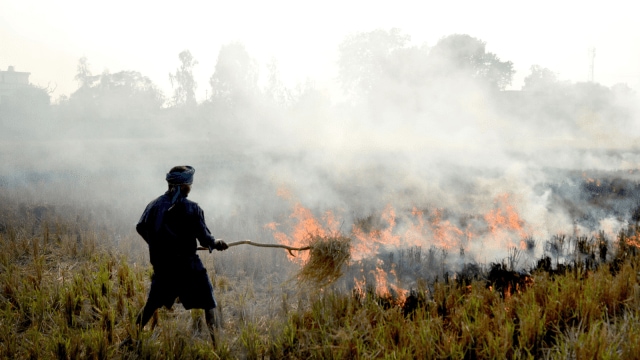‘Farmers clearing field as wheat sowing window narrowing’: Punjab sees 78% jump in farm fires in just 10 days
Year's total paddy stubble burning cases 35% less than 2024
 In just two weeks of this year's paddy harvesting season, Punjab has recorded 95 farm fires (Express photo).
In just two weeks of this year's paddy harvesting season, Punjab has recorded 95 farm fires (Express photo).In the past 10 days, Punjab has registered a 78 per cent jump in paddy stubble burning cases this season.
According to data from the Punjab Remote Sensing Centre (PRSC), the state has recorded 2,839 stubble-burning incidents between September 15 and November 4, compared to 4,394 cases during the same period last year and 14,173 in 2023. This marks a 35 per cent decline from last year and an 80 per cent decline compared to 2023.
However, from October 26 to November 4, Punjab reported 2,218 farm fires — more than 3/4 of this season’s total.
A closer look at daily trends also reveals that the fire density has surged sharply since October 26, coinciding with the completion of paddy harvesting and the beginning of the wheat-sowing period, which ideally falls between November 1 and November 15.
This season, the highest single-day spike came on November 1, when 442 fires were recorded, followed by 321 Tuesday , 283 on October 29 and 256 on November 3.
Officials said the sudden increase reflects the farmers’ urgency to prepare fields for wheat as the sowing window is rapidly shrinking.
“With every passing day after November 15, wheat yield potential drops. Farmers are clearing fields faster this year due to the delayed paddy harvest and narrowing sowing window,” said an agriculture official, adding that this year, wheat sowing has already begun, and around 30 per cent (10.5 lakh hectares) of the targeted 35 lakh hectares have been sown so far.
Among districts, Sangrur with 510 and Tarn Taran with 506 cases toped the list of farm fires, followed by Ferozepur at 296, Amritsar (249), Bathinda at 197, Patiala at 167, and Mansa at 126. Kapurthala (110), Moga (101), these nine districts alone account for around 80 per cent of all stubble-burning incidents in the state so far.
District-level comparisons show that Sangrur had recorded 629 cases in the same period last year and 2,147 cases in 2023 while Tarn Taran had recorded 579 in 2024 and 1,585 in 2023 in the same period.
On November 4, Punjab recorded 321 fresh fire incidents, up from 262 on the same day last year but much lower on the same day in 2023 when it was 1360.
While the cumulative number of fire incidents is significantly lower this year, the recent surge could narrow the gap if the trend continues.
Agriculture experts said the overlap between paddy harvesting and wheat sowing is tightening each year as monsoon withdrawal and harvesting get delayed. “This year’s paddy harvest was delayed due to prolonged rain in October. Farmers now have barely two weeks to prepare their fields for wheat, so many resort to burning despite awareness and penalties,” said an official from the Punjab Pollution Control Board (PPCB).
The official added that while the overall numbers are encouraging, the late-season fires remain a concern. “The next 10 days are crucial. The number of fires could rise as more areas complete harvesting,” the official said.
 There are 31.72 lakh hectares of land under paddy cultivation, of which 85.79 per cent of harvesting had been completed as of November 3.
There are 31.72 lakh hectares of land under paddy cultivation, of which 85.79 per cent of harvesting had been completed as of November 3.
“Despite the overall improvement in numbers compared to the past two years, Punjab’s fire map this week has once again turned red, signaling that the battle against stubble burning remains far from over — especially as the state races against the clock to finish wheat sowing before mid-November,” said another agriculture officer.
In Punjab, according to the Punjab Pollution Control Board, there are 31.72 lakh hectares of land under paddy cultivation, of which 85.79 per cent of harvesting had been completed as of November 3. Till the same date, environmental compensation had been imposed in 1,009 cases, amounting to Rs 52.75 lakh, of which Rs 23.65 lakh has been recovered.
A total of 765 FIRs have been registered against farmers under Section 223 of the BNS for stubble burning, while 946 red entries have been made in farm records. Prosecution action has been initiated under Section 14 of the CAQM Act against nine nodal or supervisory officers, and 576 warning or show-cause notices have been issued to other nodal/supervisory officers.







